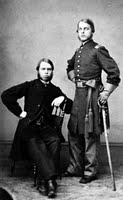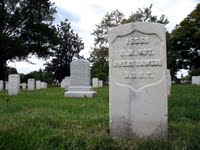
First Lieutenant Theodore Francis Wright of Dorchester, Mass., was described as a student of a serious turn of mind and a dedicated diarist. In the spring of 1864 he wrote in his journal, "I have for some time been deliberating about leaving college to go to the war, and I have, at last, with the consent of my parents, determined to study for a commission in the colored troops."
Wright (pictured here, standing on the right, in his uniform) received a commission as first lieutenant. He explained his first assignment:
"My assignment to the 108th U. S. Colored Infantry organizing at Louisville, Kentucky, came June 14th, 1864, and I was ordered to report immediately. Attached to 'F' Company, Captain John H. Lee of New York, I spent one month at Louisville, the month of August at Maysville, Ky., aiding the enlistment of negroes; September at Muldraughs Hill, Ky., guarding from guerillas the Louisville and Nashville R. R., enjoying military life exceedingly. About October first the entire regiment, under command of Lieutenant Colonel John J. Bishop of Indiana, started for Rock Island Barracks, Illinois, where we spent the long and very severe winter, guarding rebel prisoners. The men improved scanty moments of leisure to learn to read and write, while I studied over my old classics."
In March 1865, 1st Lt. Wright and his company stepped into a Rock Island photographer's studio. Each man had their
carte de visite portrait taken. Wright penned a brief note on the back of each image. On the reverse side of Kendrick Allen's
carte, Wright wrote, "Now Serg't and an excellent one, and commands dedication." Allen made the army his career after the war as a Buffalo Soldier. Wright wrote honest appraisals of his men: On the back of the
carte de visite of Pvt. Alfred Thompson is written "Second rate man."
Wright placed the entire collection of company
cartes into a photograph album and presented it to his mother, Sarah Augusta (Hunt) Wright.
Wright (1845-1907) went on to study theology and earn two degrees from Harvard University. He is best remembered for his contributions as a pastor and author. Yet the photograph album he presented to his mother, filled with brief, honest remembrances of a company of African Americans who fought for freedom, is among the most unique of all Civil War photograph collections. The album is part of the Randolph Linsly Simpson African-American Collection, James Weldon Johnson Collection in the Yale Collection of American Literature,
Beinecke Rare Book and Manuscript Library, Yale University.
Labels: 108th u.s. colored infantry, beinecke, carte de visite, civil war, dorchester, harvard, library, massachusetts, military, officer, photograph, theodore francis wright, theology, union, usct, yale



